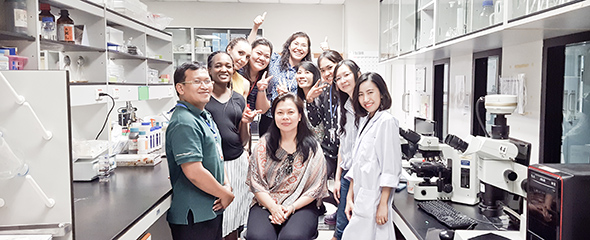Fungi are playing a crucial role in the search for new active compounds: As a rich source of metabolic products with selective biological activity, they can be used for the development of new drugs. The so-called mycobiota of tropical countries offers a great potential – the fungi in a habitat with an immense biodiversity that still remains widely unexplored. In the past years, substances with antimicrobial, cytotoxic and antioxidant effects have been isolated from tropical fungi. Additionally, these substances can also have a lethal effect on nematodes, i.e. roundworms.
"We are looking for new fungal species and genera that are suitable for the application as biological pesticides or as producers of new active compounds."
In 2015, an international research group led by Marc Stadler, head of the HZI department "Microbial Drugs" and scientist of the German Center for Infection Research (DZIF), sampled fungi in the rainforest of Thailand. The work was funded by the EU as part of the “Golden Mycological Triangle” (GoMyTri) project. In the laboratory, researchers isolated the individual fungal strains and first characterised them by sequencing – so-called genetic barcoding; representatives of known genera were sorted out. Together with other female scientists from Thailand and the Netherlands, Zeljka Rupcic and Clara Chepkirui, doctoral students in Stadler’s team, analysed the isolated strains morphologically and phylogenetically, thus discovering a new type of fungus whose living culture had attracted attention through antagonistic activities. The new fungus was named Pseudobambusicola thailandica. The fungus, as well as its extracts showed strong antagonistic activities against nematodes and fungi. The researchers extracted and identified eight natural products with antibiotic and nematicidal effects from the cultures, six of which were previously unknown to science. The biological activity of these substances is only moderate, so they are not usable for drug development. Nevertheless, the scientists are currently investigating whether the new fungus is suitable for the biological control of pathogenic nematodes and fungi in agriculture.
Stadler summarises the goals of the "GoMyTri" project as follows: "We are looking for new fungal species and genera that are suitable for the application as biological pesticides or as producers of new active compounds."
“This project represents only a small step in the research of the fungal metabolites. We still have around 30 other fungal strains to be analysed", says Clara Chepkirui. Involved in this interdisciplinary project are young chemists, biologists and engineers from Egypt, China, Colombia, Cameroon, Croatia, Kenya, Thailand, the Philippines, the Netherlands and Germany.
Original publication:
Zeljka Rupcic, Clara Chepkirui, Margarita Hernández-Restrepo, Pedro W. Crous, Janet Jennifer Luangsa-ard, Marc Stadler: New nematicidal and antimicrobial secondary metabolites from a new species in the new genus, Pseudobambusicola thailandica. MycoKeys, 2018, DOI: 10.3897/mycokeys.33.23341
Funding:
This project has received funding from the European Union’s Horizon 2020 programme within the framework of the Marie Skłodowska-Curie measure „Research and Innovation Staff Exchange” (RISE; Nr. 645701, project acronym „GoMyTri”). Financial support was received from German Academic Exchange Service (DAAD) and the Kenya National Council for Science and Technology (NACOSTI).
German Centre for Infection Research:
At the German Center for Infection Research (DZIF), about 500 scientists from 35 institutions nationwide jointly develop new approaches for the prevention, diagnosis and treatment of infectious diseases. Their aim is the rapid, effective translation of research results into clinical practice. With this, the DZIF paves the way for the development of new vaccines, diagnostics and medicines in the fight against infections. Further information at: www.dzif.de

